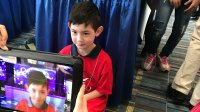Student-Created Videos in the Classroom
Students aren’t just consumers of videos—they’re producers as well. Teachers can take advantage of this to assess student learning.
Your content has been saved!
Go to My Saved Content.If you were to spend a couple of days at my house, you might see my older son watching YouTube videos to learn to play the introduction to “Sweet Child O’ Mine” by Guns N’ Roses on his guitar. Or you might see him making a stop-motion hockey video with Legos and sharing it with his grandfather and friends. My younger son might be checking out slime video recipes on my Instagram or dressing up to make a scary movie with our neighbor.
Video is a key way my children gather and share information. The same is true for my students. They aren’t just consumers of videos—they create videos to share their opinions and skills with the world.
As an elementary school teacher, I’ve found student-made videos to be a natural fit for the classroom. Video taps into the current interests and habits of my students and can easily connect them with authentic audiences. They use video to document their knowledge, reflect on the learning process, and teach others how to do new things.
4 Types of Student-Created Videos in My Classroom
1. Learning product videos: Learning product videos are often summative assignments that students create to demonstrate their learning.
One year, my students worked in small groups to create green screen videos explaining the life cycles of different animals. Watching the videos, I could see how well they understood how an organism grows and changes over its lifetime and whether they were able to use key vocabulary effectively.
Last year, at the conclusion of our economics and opinion-writing units, the second graders at my school learned about Puerto Rico and the devastating effects of Hurricane Maria. They designed a fund-raiser and recorded videos of opinion pieces they wrote about why people should donate money.
After sharing their videos with families and other students on our Seesaw blog, they raised over $300. Our students used their videos to help others, and I was able to assess their writing and speaking skills and their understanding of economic concepts.
2. Response videos: Sometimes I’ll ask my students to make a quick video in response to a question or prompt. These response videos function like exit tickets—I ask students a question about a lesson, and they record a video answer. During our sound unit, for example, they made response videos to explain how to change the pitch of a drum. These response videos are a great way to collect formative data.
Response videos can also be used to connect members of a community around a specific prompt. For National Poetry Month, our school asked students to respond to the prompt, “What is a favorite poem you have written or read?” Our students recorded 160 poetry videos on a school-wide Flipgrid. The poet Amy Ludwig VanDerwater recorded a video message for the students too. The kids loved listening to all of the different voices responding to the prompt.
3. Reflection videos: I often ask my students to make video reflections about the learning process. These videos give me insight into things that don’t always show up on formative assessments and final products.
I learn about the strategies that didn’t work and how my students solved problems. Students describe their persistence, flexibility, and optimism.
Understanding and explaining the process of learning is hard at any age, and it can be especially difficult for young students to adequately express in writing. Reflection videos offer an easy way to capture the language of metacognition.
4. Tutorial videos: Many of my students regularly watch tutorials on YouTube to learn things like how to advance in a video game or do a dance move, and they’re eager to make this type of video to share with their friends.
Tutorials are a great way for students to show deep understanding of a skill, practice, or concept. They not only know how to do something but can teach others how to do it. My students have made tutorials about things like how to code robotics projects and how to add working wheels to makerspace projects.
We share these videos with classmates using Google Classroom, reinforcing the idea that we’re all teachers and learners.
Videos are a great way for students to learn information, but the real magic happens when they get in front of the camera. Their videos teach me about how and what they’re learning, and they learn how to be good citizens in a digital world.
When my students know that their work has a purpose beyond getting a grade and an audience beyond me, they produce their best work. They love when a classmate leaves a compliment or asks a question about a video they posted on Seesaw or Flipgrid. It makes their day when a friend finds success with a tutorial they created. They celebrate when their videos help communities in need.
Video is an everyday part of my students’ lives, and it deserves to be to be a regular part of their school day as well.
